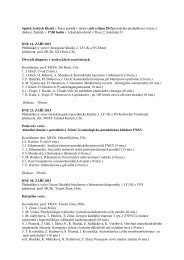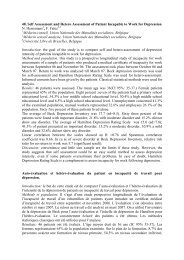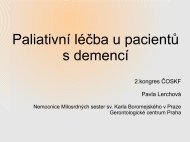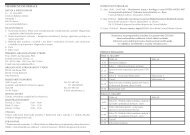ABSTRACTS â ORAL PRESENTATIONS - AMCA, spol. s r.o.
ABSTRACTS â ORAL PRESENTATIONS - AMCA, spol. s r.o.
ABSTRACTS â ORAL PRESENTATIONS - AMCA, spol. s r.o.
You also want an ePaper? Increase the reach of your titles
YUMPU automatically turns print PDFs into web optimized ePapers that Google loves.
The pore-forming activity of DDHR was investigated on individual giant unilamellar<br />
phospholipid vesicles (GUVs) made of 1,2-dioleoyl-sn-glycero-3-phosphocholine (DOPC)<br />
and DOPC with 30% content of cholesterol. Using multiphoton fluorescence microscopy<br />
we observed formations of necklace-shaped structures or internal small particles inside<br />
GUVs made of DOPC. This behaviour is consistent with the theory of pore formation<br />
as mode of action explaining the bioactivity of some particular secondary metabolites<br />
(Zemel at al., 2005). Content of cholesterol in GUVs inhibits formation of these structures.<br />
Permeability of membranes after treatment with DDHR was proved in the standard dye<br />
leakage assay performed on the same vesicle types.<br />
We have also proved the direct interaction between cholesterol and DDHR using<br />
FTIR spectroscopy. This interaction could play a crucial role in its bioactivity and<br />
the ability to stain only certain membrane components in cells.<br />
Acknowledgements<br />
This work was supported by Long-Term Research Plans of the Ministry of Education,<br />
Youth and Sports of the Czech Republic No. MSM0021620858. Author is thankful to<br />
the laboratory of RNDr. Miroslav Flieger, CSc., Institute of Microbiology, Academy<br />
of Sciences of the Czech Republic.<br />
References<br />
Berdy, J. (2005). Bioactive Microbial Metabolites. The Journal of Antibiotics, 58(1):<br />
1-26.<br />
Savic, M., Bratic, I., & Vasiljevic, B. (2007). Streptomyces durmitorensis sp. nov., a<br />
producer of an FK506-like immunosuppressant. International journal of systematic and<br />
evolutionary microbiology, 57(Pt 9): 2119-24.<br />
Stodulková, E., Kuzma, M., Hench, I. B., Černý, J., Králová, J., Novák, P., Chudíčková,<br />
M., et al. (2011). New polyene macrolide family produced by submerged culture of<br />
Streptomyces durmitorensis. The Journal of antibiotics, 64(11): 717-22.<br />
Zemel, A., Ben-Shaul, A., May, S. (2005). Perturbation of a lipid membrane by amphipathic<br />
peptides and its role in pore formation. European biophysics journal, 34(3): 230-42.<br />
P12. MODULATION OF HYPERICIN-MEDIATED PHOTODYNAMIC THERAPY USING<br />
HISTONE DEACETYLASE INHIBITORS<br />
Ján Kovaľ, Andrea Halaburková, Rastislav Jendželovský, Jaromír Mikeš, Peter Fedoročko<br />
P. J. Šafárik University in Košice, Faculty of Science, Institute of Biology and Ecology,<br />
Košice, Slovak Republic; jan.koval@upjs.sk<br />
Photodynamic therapy (PDT) is a minimally invasive cancer treatment method which<br />
utilizes different tumor-localizing agents that are activated by irradiation with light<br />
of a specific wavelength. This triggers production of reactive oxygen species, which<br />
subsequently activate processes implicated in irreversible changes to various cellular<br />
targets leading to cell death (Dougherty et al., 1998). Hypericin (HY), a naturally occurring<br />
aromatic polycyclic diantraquinone from St. John’s wort (Hypericum perforatum L.), has<br />
unique photocytotoxic properties suitable for PDT.<br />
Analytical Cytometry VII 101








